There are so many reasons why I love my vanilla American buttercream recipe. The first is that is only uses 5 ingredients which most of us already have in our pantries!
It also is seriously the easiest recipe to make. It’s pretty much foolproof and only takes about 5 minutes to make.
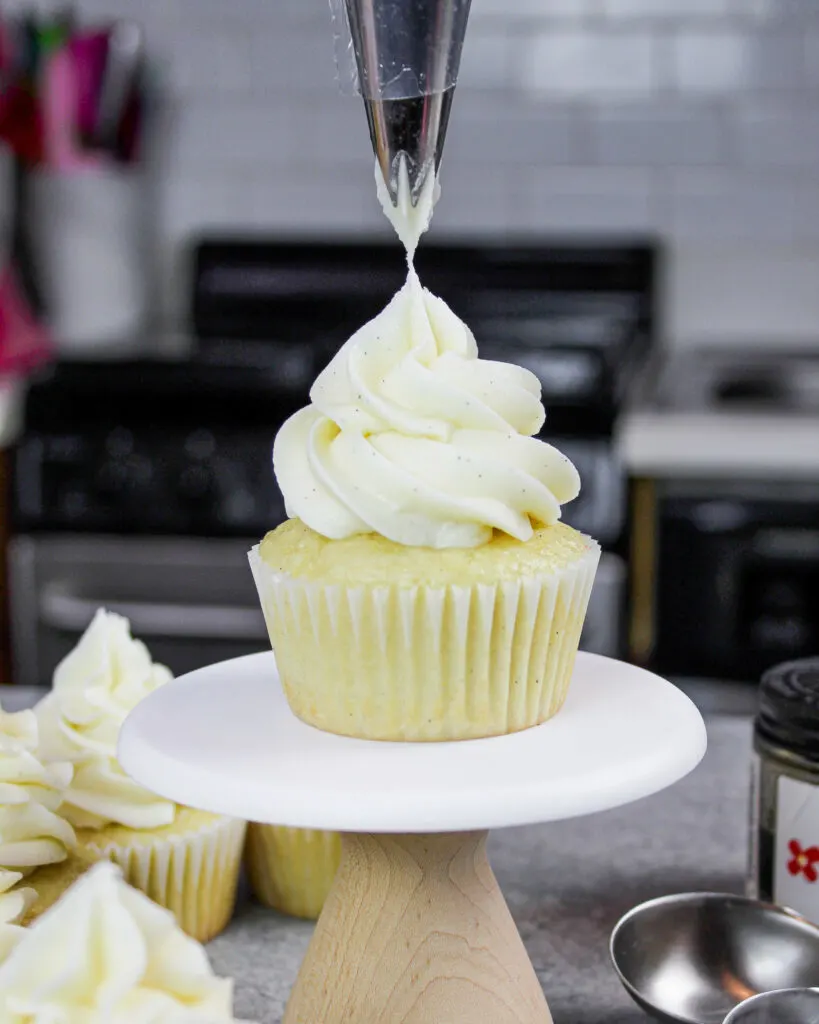
However, as with any recipe, sometimes you need to do a little trouble shooting! I get TONS of questions about my buttercream recipe, including the following:
- Can buttercream icing be made ahead of time?
- Can buttercream frosting be frozen?
- How do I get the air bubbles out of my buttercream?
- Can buttercream frosting be left out overnight?
- Which type of buttercream is best for cakes?
- Why does my frosting have air bubbles in it?
- Does buttercream need to be refrigerated?
- Why is my buttercream grainy?
- Why is my buttercream yellow?
- How do you make your frosting white?
- How do you get such vibrant colored frosting?
I’m here to answer all of these and more! So, buckle up and get ready to learn everything (and more) about American buttercream frosting.
I’ll be sharing the fundamentals, tips for troubleshooting, and of course my tried-and-true recipe!
I also walk through exactly how I make my American buttercream in this video.
Can I Make My Buttercream in Advance?
A common theme in these questions involves making buttercream in advance and storing it.
I almost always make my frosting ahead of time.
If placed in a large, sealed piping bag or airtight container it can last in the fridge for up to a month and in the freezer for up to three months.

When you’re ready to use the chilled or frozen buttercream, simply take it out of the fridge or freezer and place on the counter to thaw.
The amount of time it takes to thaw can vary based on the amount of frosting and how it’s stored. I usually take my buttercream out the night before I need it and let it slowly warm to room temperature.
However, once the buttercream has reached room temperature it will likely be riddled with tiny air bubbles!!
But fear not, I promise you can get your frosting back to a silky-smooth consistency.
Mix it on a low speed with a paddle attachment or by hand with a rubber spatula. It’s an arm workout to mix it by hand for a couple minutes, but it makes a big difference.
Be sure to really push the frosting against the side of the bowl to push out all that trapped air.
I do this with every batch of buttercream to make it easier to get super smooth sides on my cake.
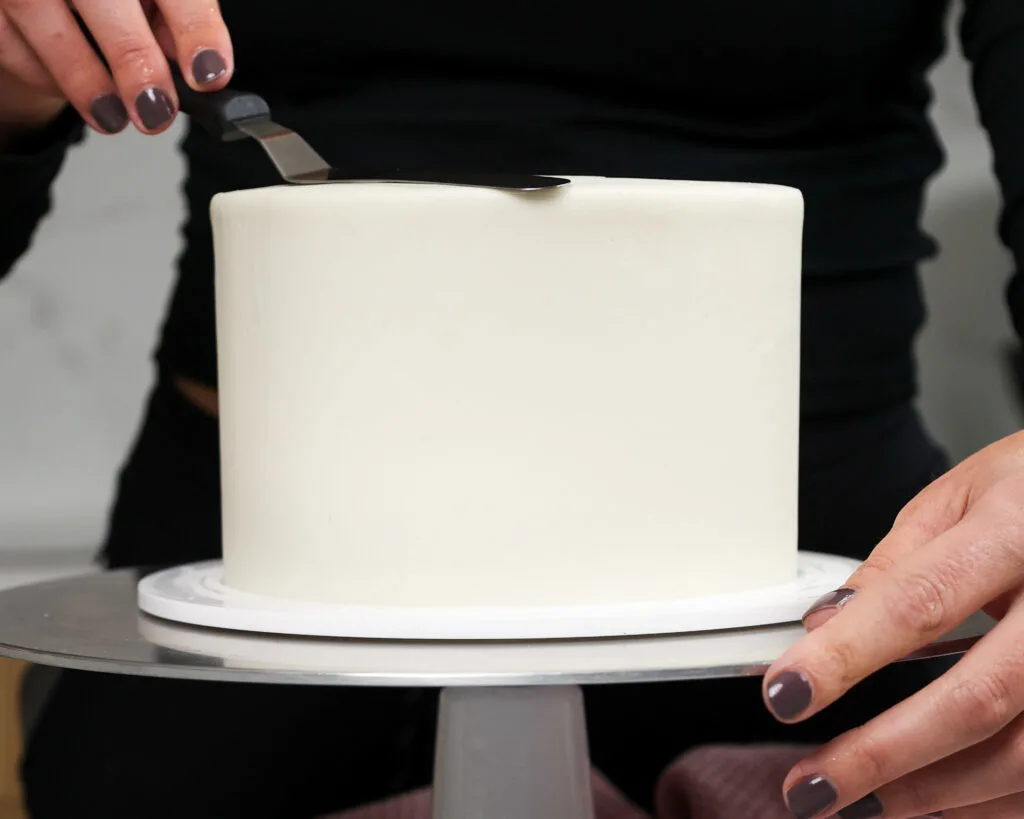
How Long Does Buttercream Keep at Room Temperature?
In general, buttercream can sit out at room temperature for up to 2 days.
Most people freak out when they hear that. “Won’t it spoil??” “But this recipe has cream in it!! Won’t the frosting go bad?”
The short answer is no. The high amount of fat and minimal amount of heavy cream gives my American buttercream a great shelf life.
I leave my frosting out overnight all the time and have never gotten sick from it.
In fact, I even left my frosting out overnight to decorate my own wedding cake and it tasted great.
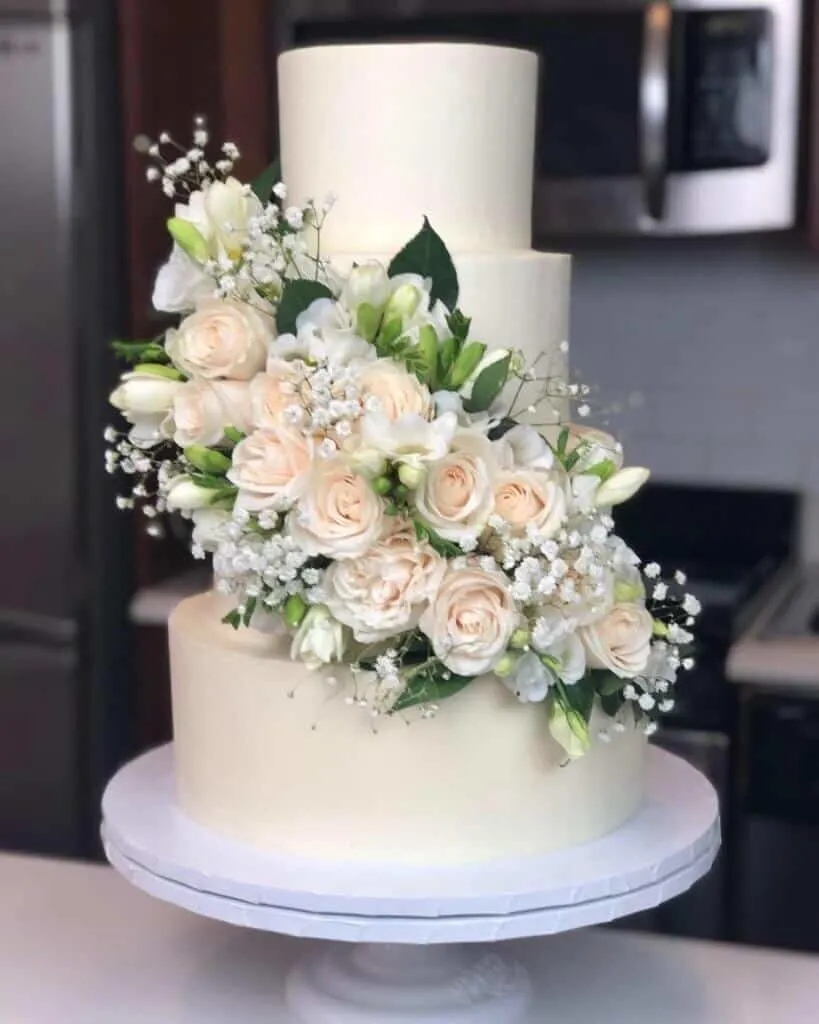
Do I Need to Sift My Powdered Sugar?
A lot of recipes ask you to sift the powdered sugar before adding it into the frosting. I don’t know how you feel about sifting, but to me it’s always such a pain!
It is important to sift the powdered sugar if you have trouble with it clumping when you add it into your buttercream.
However, most powdered sugar in the United States is mixed with a tiny bit of cornstarch to keep it from clumping. It usually discloses this on the front of the package.
Cornstarch helps absorb moisture which naturally prevents clumps from forming.
I’ve never had an issue with my powdered sugar clumping so a few years ago I decided to be rebellious and not sift my powdered sugar.
And you know what? My frosting turned out EXACTLY THE SAME! Ever since that day I’ve never sifted my powdered sugar when making frosting.
If you live in a humid environment or in a place in the world where powdered sugar isn’t mixed with cornstarch, you may have issues with clumps in your powdered sugar.
If this is you, it may be necessary for you to sift.
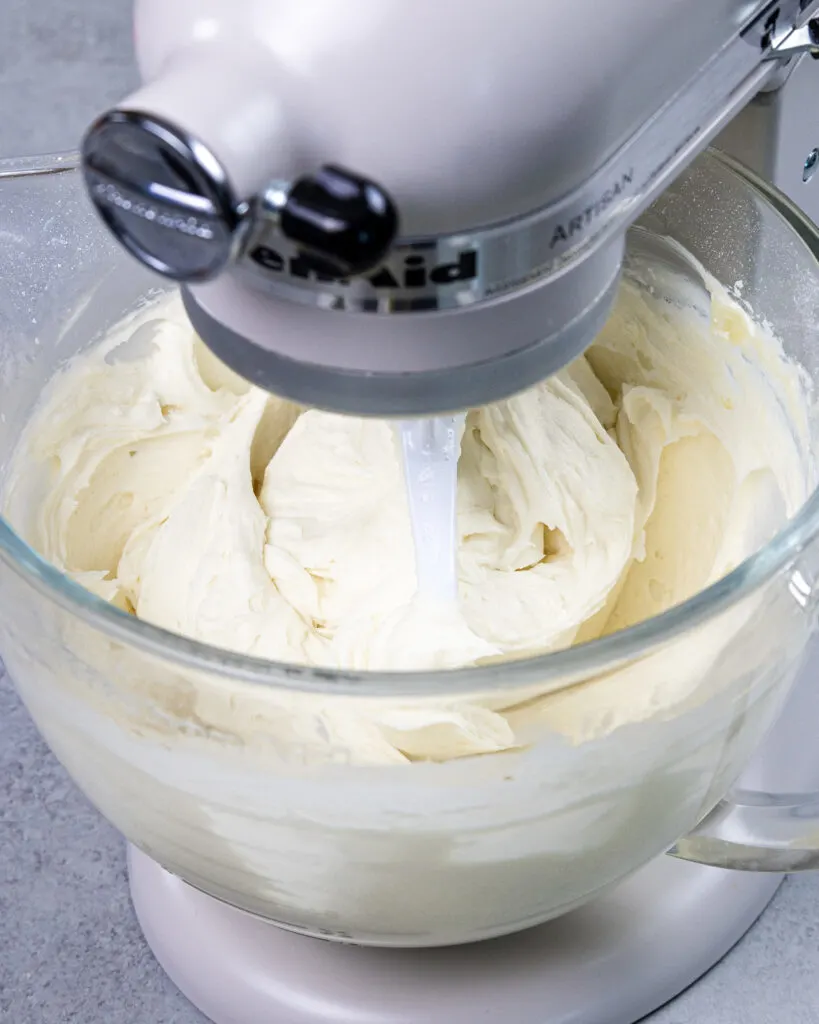
Why Is My Buttercream Grainy?
Some people also run into the issue of grainy frosting!
When the texture of your buttercream isn’t nice and smooth, it may be because you need to add a bit more heavy cream. I recommend adding 1 additional Tablespoon at a time to make sure you don’t throw off the consistency of your frosting.
If there isn’t enough liquid in your frosting to help dissolve the powdered sugar, it can throw off the texture of your frosting.
But sometimes adding additional heavy cream doesn’t solve the problem.
When you run into this, the grainy texture might be caused by the brand of powdered sugar you’re using!
Some brands are less fine than others and in some place of the world powdered sugar is also less fine.
I usually use the Domino or Shoprite brands, which are both 10x.
When you see this on a package, it refers to the number of times the sugar is processed to make it into the fine powder that we know and love.
Be sure to check your package when you buy it, to be sure it’s been processed to a fine enough powder!
Why Is My Buttercream Hard / Why Does Buttercream Crust?
Another important thing to note when making this recipe is that it is a crusting buttercream!
Now I know what you’re thinking, “crusting sounds gross!!” or “why would frosting crust?”
My American buttercream recipe crusts overtime as the frosting is left exposed to air due to its high sugar content.

But it’s really not a bad thing. In fact, most of the time it’s actually a great thing! I like that it firms up, especially when I use it on cookies like these buttercream cookies.
Crusting buttercream recipes are usually stiffer due to the high amount of powdered sugar and therefore easier to smooth on cakes.
Other benefits of crusting include reduced risk of bulging sides, the ability to paint designs onto a cake and it helps piped flowers or designs keep their structure.
I used this frosting recipe to make this winter wonderland cake and it piped like a dream!
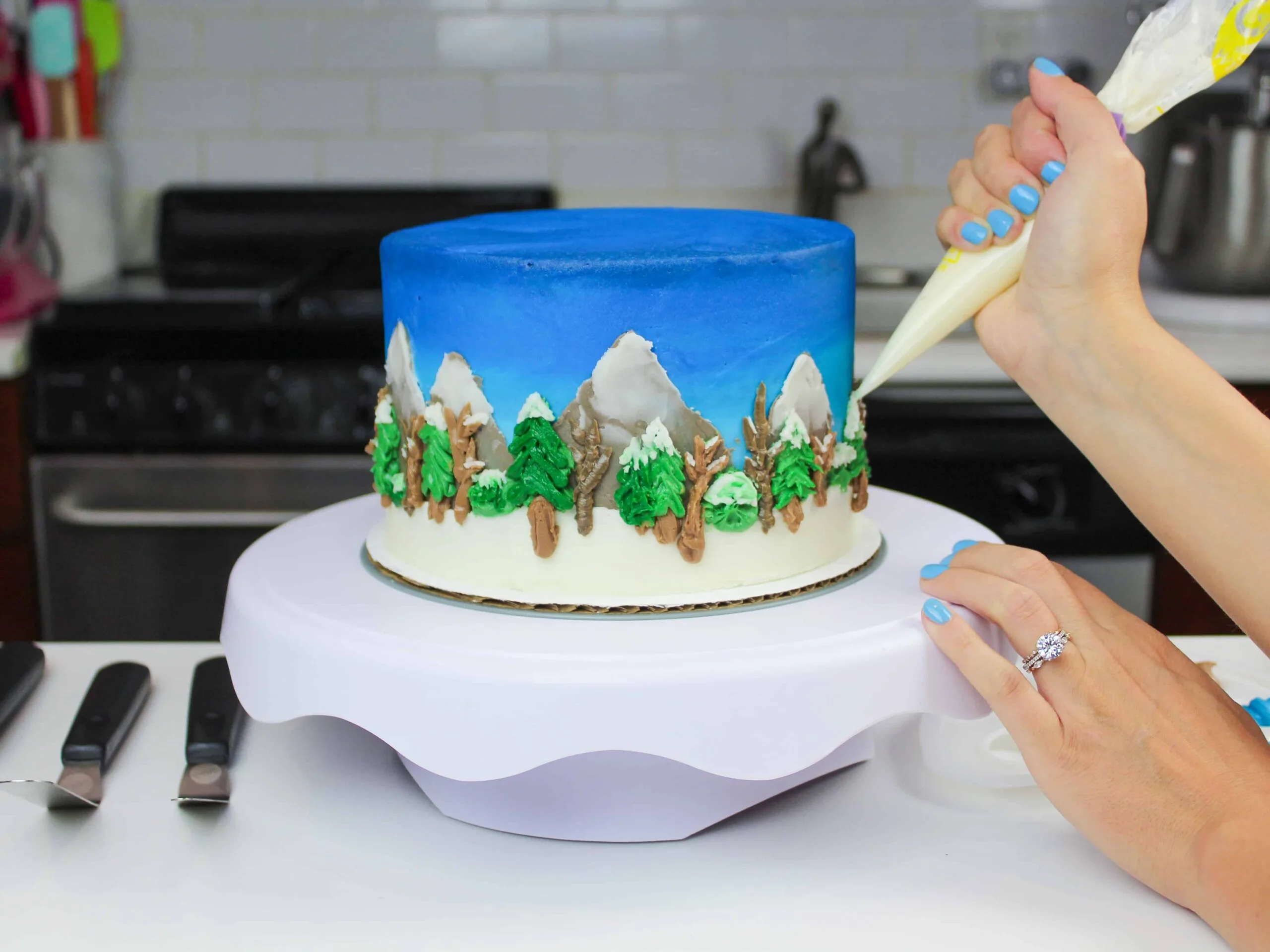
If you want to use a frosting that doesn’t crust, I recommend trying my Swiss meringue buttercream or Russian buttercream.
What Is American Buttercream Frosting? How Is It Different than Swiss Meringue Buttercream?
Based on the amount of powdered sugar in this recipe, you can probably tell this is an American Buttercream Frosting (ABC)!
The noticeable difference between American buttercream and other types of frosting is that it doesn’t use any egg whites!
American buttercream frosting is primarily made with butter, loads of powdered sugar, and a bit of salt, vanilla, and heavy cream.
While there are tons of delicious types of buttercream out there (Swiss, German, Italian, Russian…), I prefer ABC!
I don’t usually want to mess with eggs when it comes to frosting and I enjoy the way American buttercream tastes.
As most of you know, I have a huge sweet tooth and Swiss Meringue Buttercream (SMBC) honestly isn’t sweet enough for my palette.
I ate loads of sugary candy, sweet breakfast cereals and sweetened beverages as a kid. My brain has been hard-wired over the years to just love sugar.
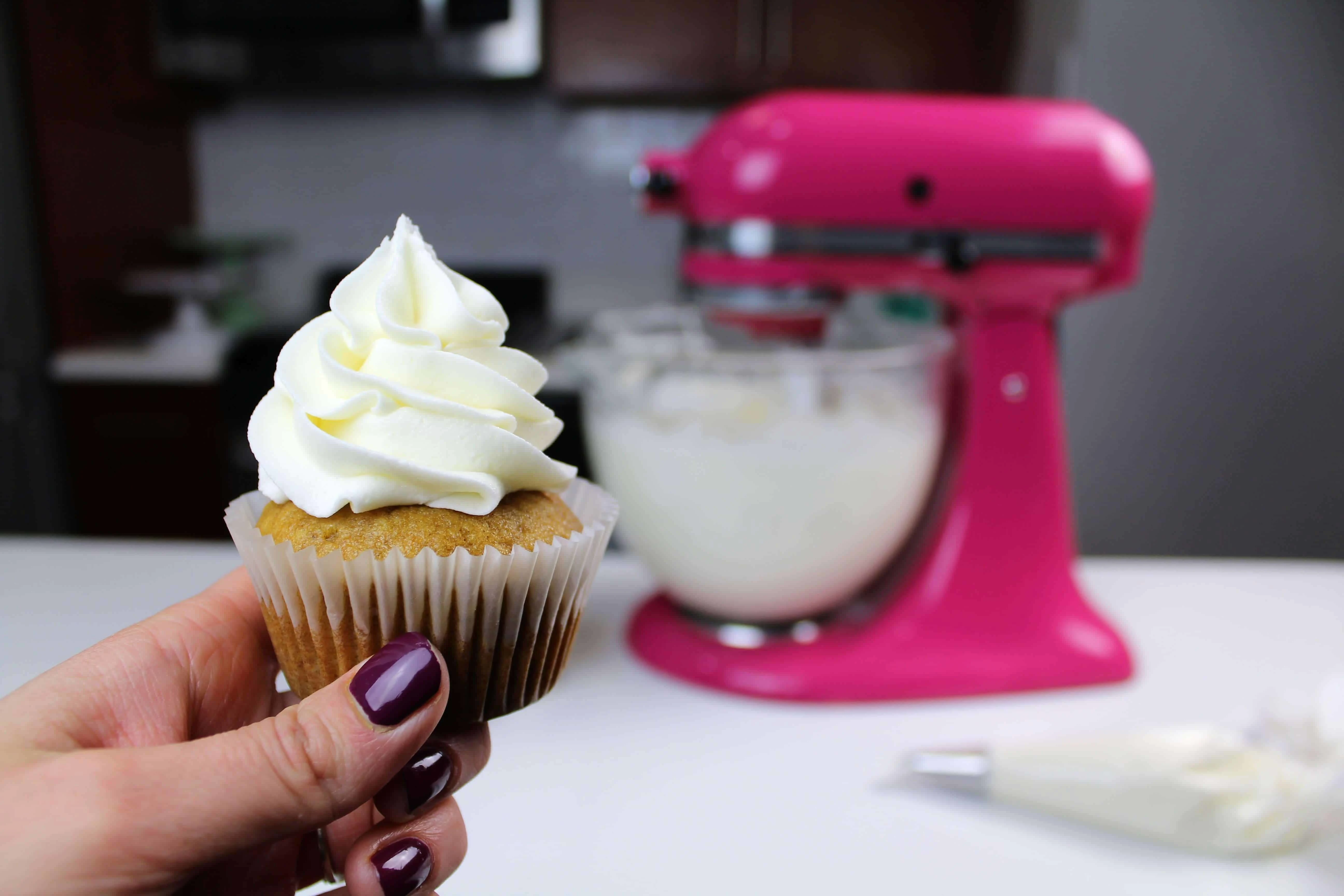
How Do I Make My Buttercream White? Why Is My Buttercream Yellow?
One last thing to note when making this American Buttercream is about its color. Since this recipe is only 5 ingredients, each one really counts when it comes to the look, flavor, and consistency of this frosting.
With this in mind, the brand of butter you use has a huge impact on the taste and color of your frosting!
Some brands of butter are more yellow, based on a couple different things.
The first is the diet of the cows producing the milk! Cows eating a lot of grass will produce yellower butter due to the beta carotene in the grass.
Another factor is if a brand adds in coloring. I recommend always checking the ingredients.
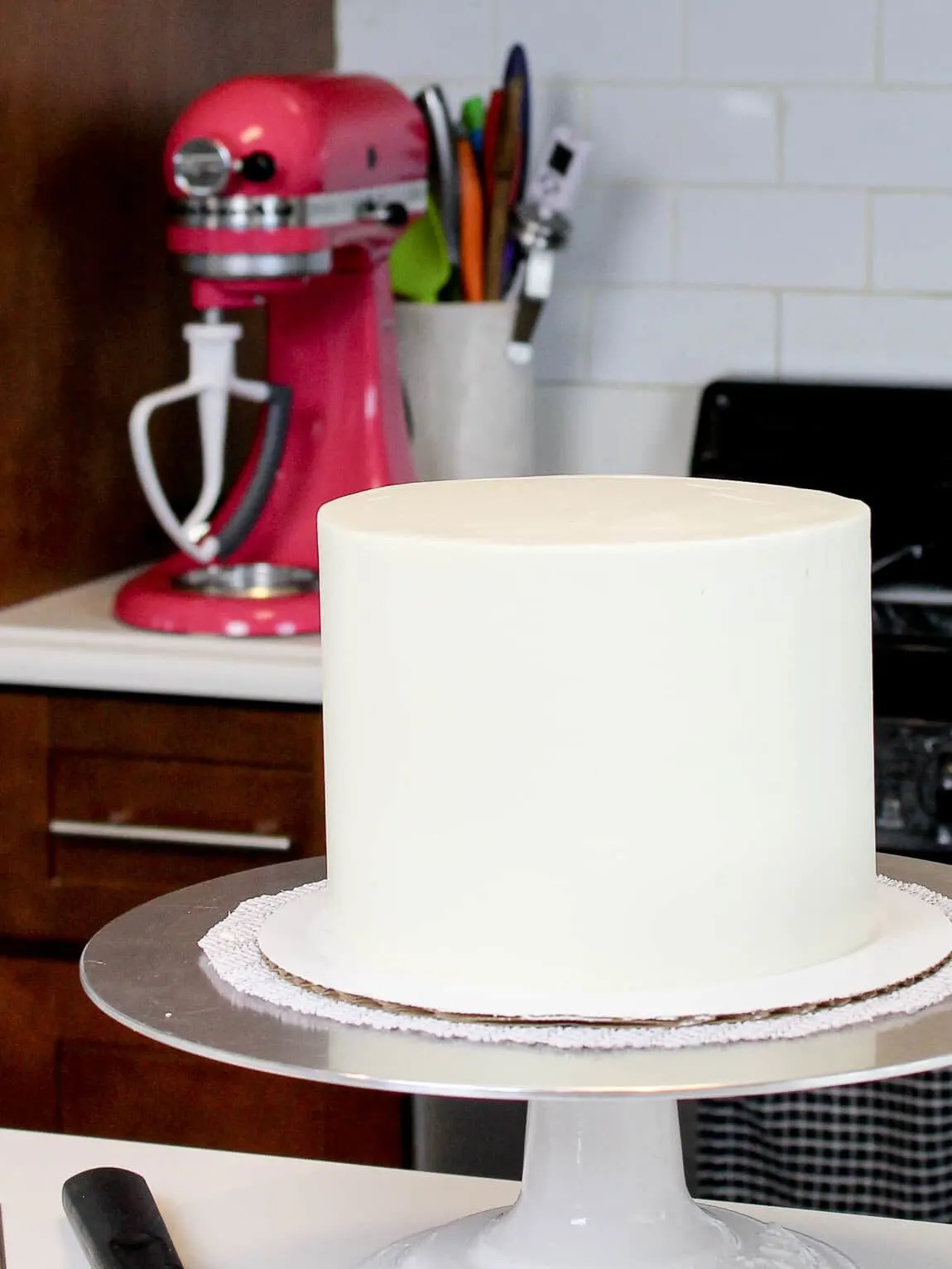
My go to brand of butter is the unsalted Whole Foods brand. It is very light in color and makes very white frosting!
If you can’t find a brand of butter that is lighter in color and your frosting is still a bit yellow, there are a few different tricks you can try to brighten up the color of your frosting.
My first trick for making white buttercream is to whip your butter on a high speed with a whisk attachment for a few minutes. This will help incorporate air into the butter which will naturally lighten its color.
The second trick is to try adding the smallest (TINIEST) drop of purple gel food coloring.
It sounds crazy, but purple and yellow are opposites on the color wheel, so they cancel each other out.
The purple gel food coloring will color-correct the yellow tint, leaving you with white frosting.
The final trick you can try is adding white gel food coloring to brighten it! This usually works great as well!
Can I Use This Recipe to Make Other Flavors of Frosting?
I use this recipe as the base of almost every frosting I make. It’s incredibly versatile and easy to color and flavor. The possibilities are limitless!
Sometimes I add in melted dark chocolate to make a decadent chocolate American buttercream.

I also love to make salted caramel buttercream but adding in a bit of my homemade caramel sauce.
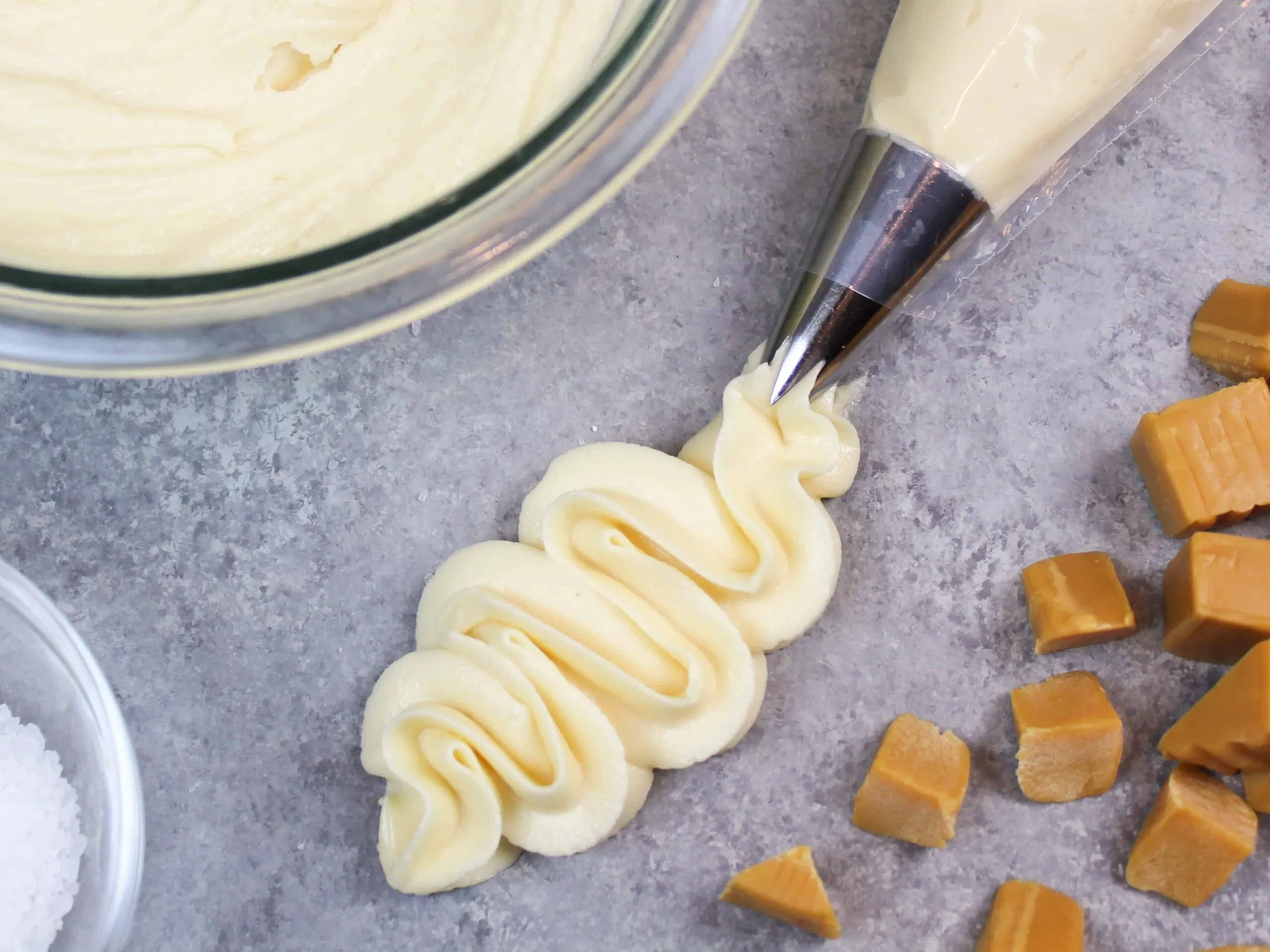
Some of the different flavors I’ve made include the following:
- Oreo Frosting
- Real Strawberry Frosting
- Salted Caramel Frosting
- Peanut Butter Buttercream
- Cream Cheese Frosting
- Raspberry Frosting
- White Chocolate Buttercream
- Orange Chocolate Buttercream
- Vegan Frosting
When I make variations and plan to use a different extract, I usually swap out 1 or 2 tsp of vanilla and replace them with my extract of choice.
This is what I do for coconut, lemon, mint, almond, ube, and maple buttercream!
Some flavors require mixing in an addition ingredient, like Nutella, Oreo, or peanut butter.

For these, I replace 1 or 2 sticks of butter with the ingredient of choice. For example, to make Nutella frosting, I use three sticks of butter, and a half cup of Nutella.
I then add some additional heavy cream because the Nutella makes the frosting thicker than regular buttercream.
This approach works great for cream cheese frosting, salted caramel, peanut butter, Nutella, strawberry, and cookie butter frosting.
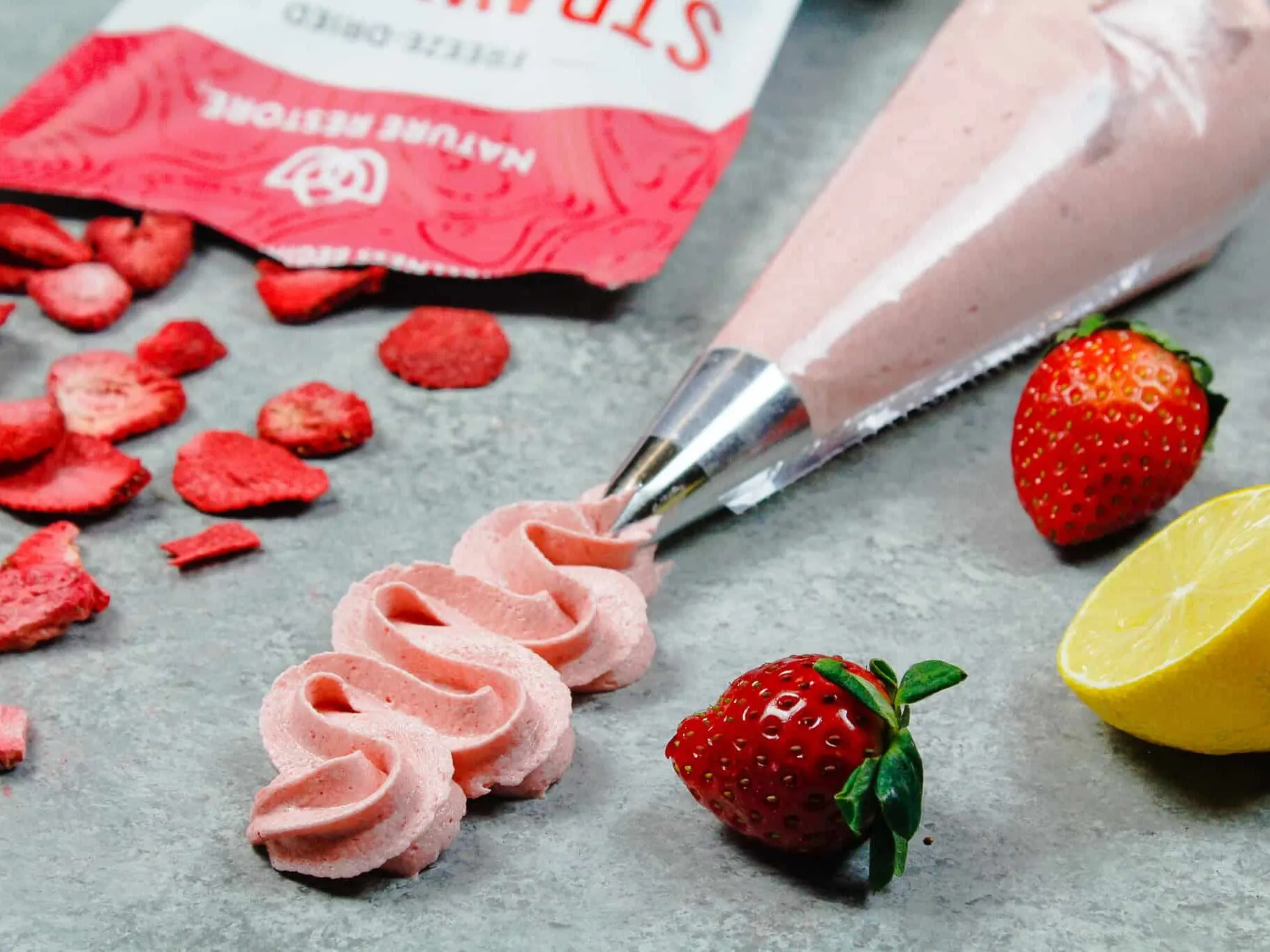
How Do I Color My Buttercream to Make Bright And Vibrant Shades?
Now onto coloring frosting! To make my buttercream super vibrant and colorful, I use gel food coloring.
It allows you to get vibrant colors without adding a ton of liquid into the frosting. I avoid liquid food coloring because it can throw off the consistency of the buttercream if you add too much.
My favorite gel food coloring is Americolor. It works so well and makes coloring buttercream a breeze! I used different Americolor shades to color the frosting for me Cocomelon cake, and I loved how vibrant it looked!

While some colors are easy to make, others can be more challenging.
I have separate post that share all my tips and tricks for making black buttercream and red buttercream frosting.
How Much Buttercream Do I Need to Make For A Cake?
When using this to frost my favorite vanilla layer cake recipe , I usually make 1.5 batches. However, this can vary based on how I’m decorating the cake.
A lot of the time I have leftover frosting, but I’d always prefer to have leftover frosting, rather than run out!
I don’t mind since it can easily be saved to use on another cake.
Plus, like I mentioned above, leftover buttercream keeps in the fridge for up to a month if it’s stored correctly!
One batch of this recipe makes about 6 cups of frosting. When you’re first starting out though, that doesn’t mean much!
You’ll learn overtime how much frosting you like to add between the layers and how much extra frosting you need to create the decoration you have in mind.
A great resource you can use if you’re unsure how much buttercream you need is my buttercream calculator!
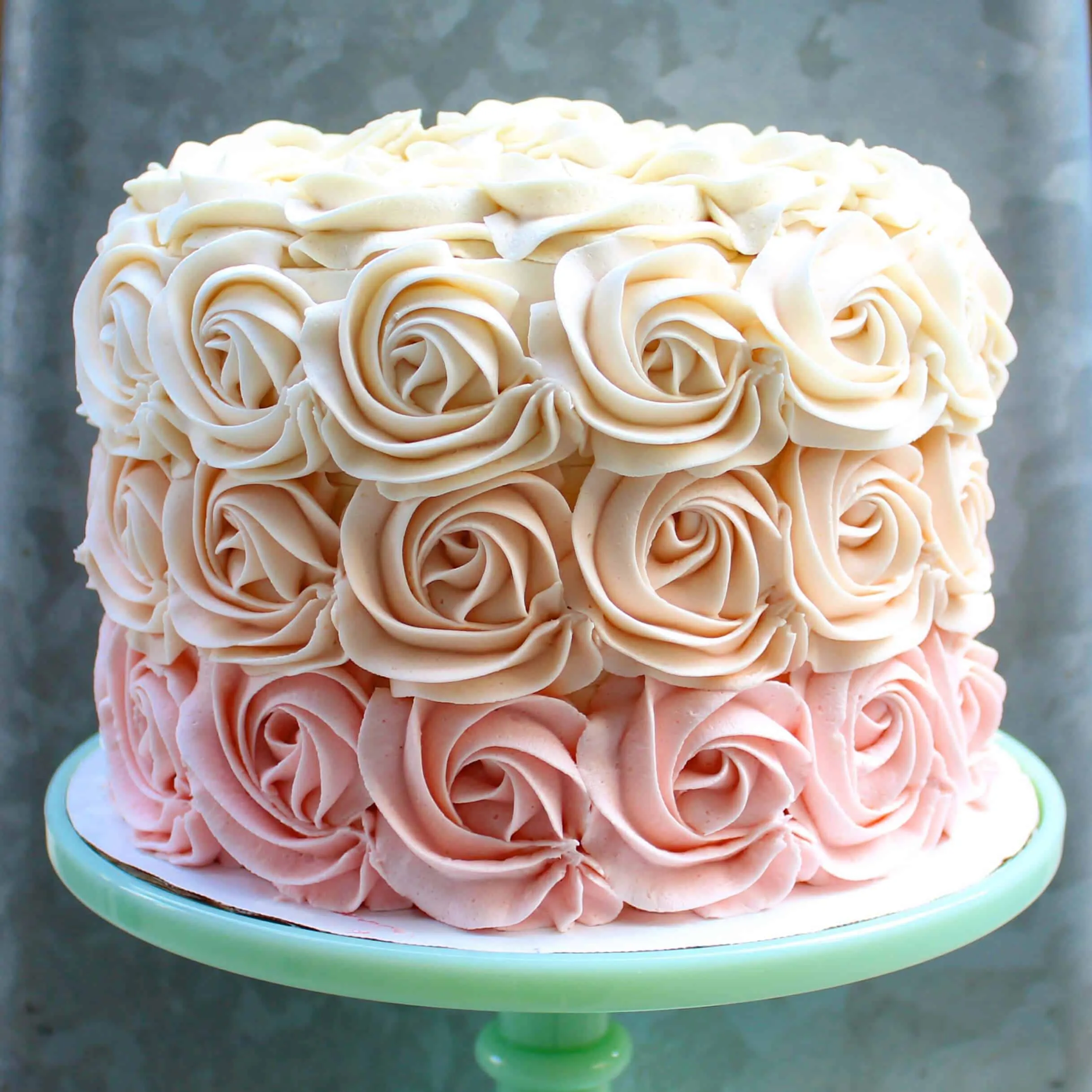
For example, a semi-naked cake uses less than one batch of frosting.
On the other hand, if you chose to decorate a cake with buttercream rosettes, you may use two entire batches of frosting!
Tips for Making the Best American Buttercream Frosting
- Use a paddle attachment if you plan to add this frosting to a cake, to make super smooth frosting that’s easy to smooth
- Make sure your butter is at room temperature to give your frosting the right consistency
- If you don’t have some of the ingredients on hand, check out my substitutions guide!
- Place a kitchen towel over your stand mixer as you add in the powdered sugar to prevent it from splattering out.
- Check the buttercream consistency by stirring it by hand with a rubber spatula and adjust as needed.
- If the frosting is too thick, add in additional cream (1 Tbsp at a time)
- If the frosting is too thin, add in more powdered sugar (quarter cup at a time).
- Mix your frosting on the lowest speed for a couple minutes once it’s made and/or stir by hand with a rubber spatula to make super smooth frosting.
Let Me Know What You Think!
If you try out this vanilla American buttercream recipe (or any of my other frosting recipes), I’d love to hear what you think of it! Please leave a comment below.
Also be sure to tag me @chelsweets and use #chelsweets so I can see your creations 🙂
Other Recipes You Might Like:
Vanilla Buttercream Frosting
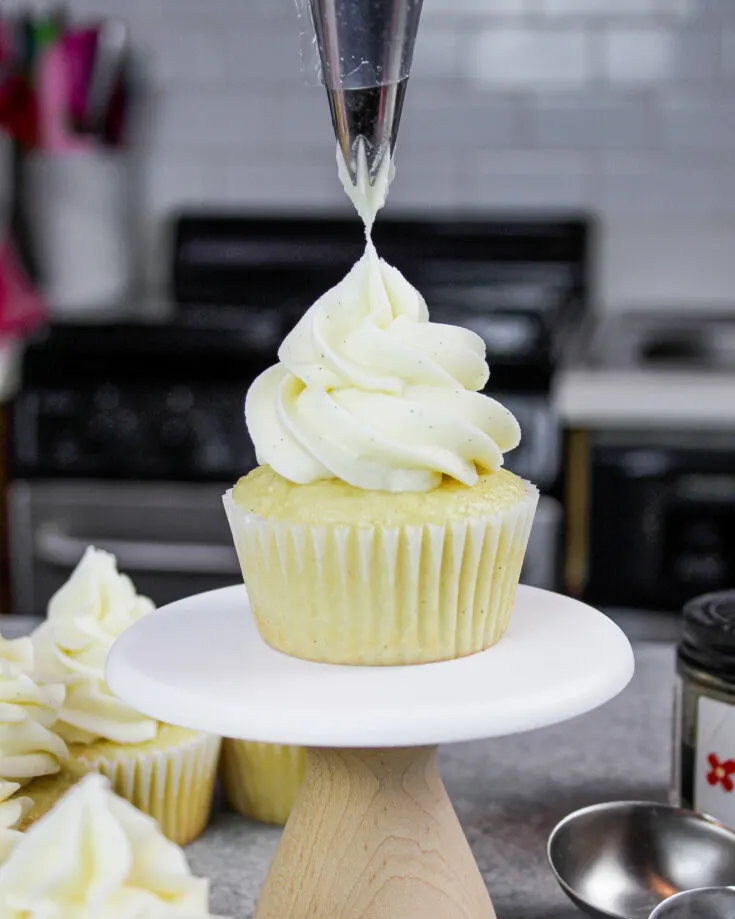
This American buttercream recipe only uses five ingredients! It's so delicious and easy to make, you'll never buy frosting again!!
Ingredients
- 2 cups unsalted butter, room temperature (452g; 1 lb. box)
- 1 Tbsp vanilla extract or vanilla bean paste (12g)
- 1/2 tsp fine salt (3g)
- 7 cups powdered sugar (907g; 2 lb. bag)
- 3 Tbsp heavy cream or whipping cream (45g)
Instructions
- Beat 2 cups of unsalted butter on medium speed for 30 seconds until smooth with a paddle attachment / stand mixer or a hand mixer.
- Mix in 1 Tbsp vanilla extract or vanilla bean paste and 1/2 tsp salt on a low speed.
- Slowly add in 7 cups of powdered sugar while mixing slowly on the lowest setting. Halfway through add in 3 Tbsp of heavy cream or milk to make it easier to mix. I like to place a kitchen towel over my mixer to contain any powdered sugar clouds.
- Mix on low until the ingredients are fully incorporated and the desired consistency is reached. Scrape the sides and bottom of the bowl as needed with a rubber spatula.
- If the frosting is too thick, add in additional cream (1 Tbsp at a time). If the frosting is too thin, add more powdered sugar (a quarter of a cup at a time).
- If you plan to color the buttercream, add in the gel food coloring once the frosting is fully mixed and beat on low until it reaches the desired color.
- To make the frosting extra smooth, stir it by hand with a rubber spatula for a minute or two right before you use it. It's an arm workout, but it's worth it! Push the frosting back and forth and spread it around the side of the bowl. This will push out any extra air and make it easier to smooth onto cakes or pipe with.
Notes
Yield:
One batch of buttercream makes about 6 cups, which is enough to frost a 7-inch or 8-inch layer cake with 3 layers, or frost about 3 dozen cupcakes.
If you're struggling to get your frosting smooth I share all my tips for making super smooth buttercream here.
Making This Vanilla Buttercream Frosting in Advance:
Make your frosting ahead of time or save any leftover frosting! It can be stored in an airtight container in the fridge for up to a month, or in the freezer for up to 3 months.
Be sure to give it a good stir once it thaws to get the consistency nice and smooth again.
A frosted cake can last in the fridge for up to a week, or in the freezer for up to a month. The buttercream locks in all the moisture, keeping the cake fresh and delicious!
If you cut into the cake and have leftovers, use any remaining frosting to cover the cut section to keep it moist and store it in the fridge for up to a week.
If you are making this frosting for a cake, mix the buttercream on the lowest speed at the end of the process for a couple of minutes, to get out any extra air that might have been incorporated during the mixing process.
Nutrition Information
Yield
6Serving Size
1Amount Per Serving Calories 1091Total Fat 66gSaturated Fat 41gTrans Fat 0gUnsaturated Fat 21gCholesterol 177mgSodium 208mgCarbohydrates 129gFiber 0gSugar 126gProtein 1g

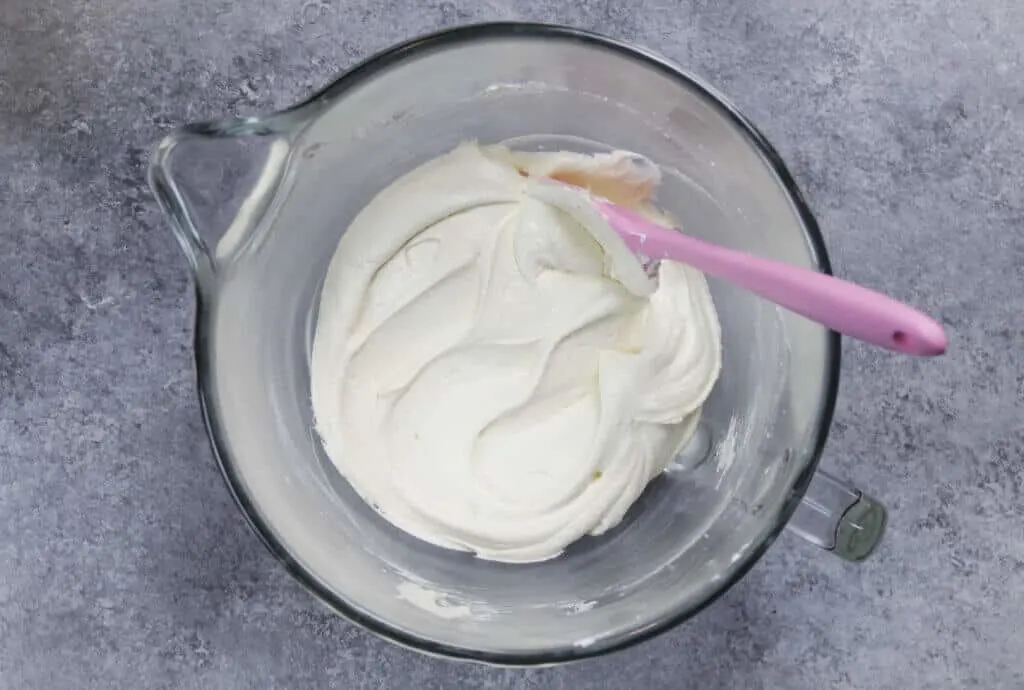



Donna
Wednesday 16th of October 2024
Do you mix this on high speed or low speed. I saw low at the end but was wondering if you mixed on high speed once it's incorporated.?
Chelsweets
Sunday 20th of October 2024
Hi Donna,
I know it's crazy, but I never mix it on high! I do exactly what the recipes says - that's what keeps it so smooth. Sounds crazy, but low and slow is how I like to make my frosting :) Hope that helps, happy baking!
KatherineH
Monday 14th of October 2024
I made this vanilla frosting for a half-chocolate and half-vanilla cake and it was the best (and easiest) buttercream that I’ve ever tried. Just delicious and, I think, better than the chocolate buttercream. I wonder if just adding melted chocolate to the vanilla buttercream would work?! Thank you a delicious recipe! I’m sure that I’ll make it again & again.
Chelsweets
Sunday 20th of October 2024
I am so happy to hear that Katherine!! You can totally add just melted chocolate to this recipe :) it won't have quite as strong of a flavor as if you added in cocoa powder as well, but it'll still be great!
You can also use my chocolate American buttercream recipe - here's the link: https://chelsweets.com/easy-chocolate-buttercream-recipe/
Hope that helps, happy baking :)
Julia
Monday 7th of October 2024
I made this frosting for my daughters wedding cake recently. It was really good and worked well. I added 1 Tbs. Flour with the powdered sugar and I replaced half of the cream with French vanilla coffee creamer because I ran out of vanilla. Thank you.
Claire
Wednesday 2nd of October 2024
Do I have to use heavy whipping cream? If I didn't, would the texture still be fine for decorating?
Chelsweets
Sunday 6th of October 2024
You can use milk or alternative milk if needed! The consistency will be a bit thinner though, so I'd add a bit less that the recipe calls for! Hope that helps, happy baking!
Most Delicious Frosting Recipes - alpha ragas
Tuesday 1st of October 2024
[…] 8. American Buttercream […]